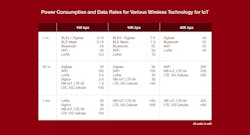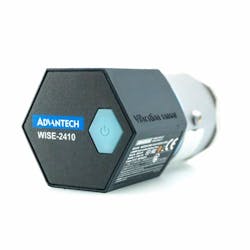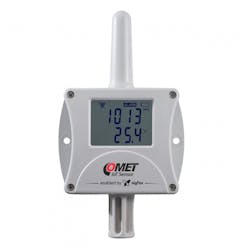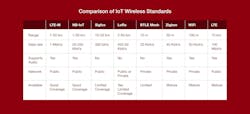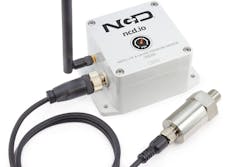Standard industrial sensors detect specific physical properties like temperature, pressure, and presence/absence. They also respond to changes in such properties. As such, one may think the only difference between a sensor and an IoT (Internet of Things) sensor is the IoT sensor communicates over the internet, enabling monitoring of devices and systems from anywhere. This is partially true.
For example, a temperature sensor in a standalone freezer detects a change in temperature and sends a signal to the compressor to turn on if the temperature exceeds a certain set point or turn off if the temperature goes below a setpoint. All this action takes place within the appliance with no connection to the outside world.
On the other hand, a smart freezer uses IoT-enabled temperature sensors in a similar manner but can transmit temperature and other pertinent data via the internet. Persons using a smartphone, tablet, or desktop computer can monitor this data and potentially control the appliance remotely.
According to Robert Jones, system architect at system integrator Polytron Inc., there are two types of IoT sensors: IoT-enabled sensors and true IoT sensors. Comparing types, he said, “An IoT-enabled sensor will have an embedded protocol, allowing it to share data over the internet. A standard non-IoT sensor lacks the internet protocol and typically hardwires to local I/O that feeds a PLC for control and monitoring.”
Jones said, “Using the freezer example, a more typical approach is for the freezer itself to be IoT-enabled compared to using individual sensors, similar to how a home appliance is IoT enabled or made smart. That is, the sensors in the freezer connect to a controller, which is accessible via the internet, so all information in the controller is accessible remotely. This is different from a true IoT sensor, such as a soil humidity sensor in a farm, where a local controller may not exist, and the sensor sends information directly to the cloud for remote monitoring.”
Integrating an IoT Platform
Companies requiring remote monitoring of their processes may enlist a system integrator to assess what hardware and software they have and specify what additional assets are necessary to build an IoT platform. Once the client agrees upon additional components and the cost, the integrator develops and executes an integration plan. Post deployment, the integrator may also continue to test and update the system.
Establishing such IoT connectivity, however, does not necessarily create an automated paradigm. Jones explains, “IoT platforms are typically used in applications requiring remote monitoring and less so for in-plant automation applications, where a local controller provides this control. In this case, it makes more sense to wire sensors directly to local I/O that feeds into the controller to provide tighter control, faster speed, easier troubleshooting, and higher security. Local control prevents inherent lag and network interruptions when traversing the Internet. For in-plant applications, we see mostly cases where IoT sensors feed into an IoT platform in the cloud for monitoring line performance, predictive maintenance, energy usage, and other applications.”
Deploying an IoT platform has several advantages. For example: IoT sensors can detect and identify potential mechanical and electronic problems. Also, wearable IoT sensors connect workers to management via mobile communications, ensuring both efficient workflows and worker safety.
Boris Shiklo, chief technology officer at system integrator ScienceSoft, cites cost reductions, shorter times to market, mass customization, longer uptimes, less waste, and greater safety as the main drivers for integrating IoT platforms.
Key questions
Because sensor types chosen for IoT integration depend on the application, an IoT sensor deployment can range from a few sensors to hundreds or more.
Regardless of the application, choosing the proper sensor for an application requires basic considerations. Jones recommends getting answers to seven questions when choosing an IoT sensor:
- Should the sensor be battery-powered or hardwired?
- How much data will it collect and how often does it need to transmit?
- Hardwired to I/O or wireless?
- Does it make sense for the data to be consolidated in a local controller with other data so that only insights are transmitted?
- How will data be presented and contextualized?
- What is the purchase and installation cost?
- What are maintenance costs?
Wireless sensors
According to system integrator Voler Systems, the wireless standard chosen for an IoT sensor can influence its performance, usability, security, and reliability. Points to consider are the application, how much power the sensor needs, how far and fast it will have to transmit data, and the type of data it supports. Other points to consider include network topology, operating frequency, and cost.
Several standards are available, the more traditional being cellular, Wi-Fi, Zigbee, and BLE. These can transmit high volumes of data; however, they are short range and power hungry.
Other standards include LoRa, Sigfox, and NB-IoT. According to Radio Bridge Inc., manufacturer and integrator of long-range wireless IoT sensors, LoRa supports data transmissions over long distances via LoRaWAN (long range wide area network layer).
Sigfox connects devices directly to base stations. It transmits data over long ranges, but rates are slow. Radio Bridge says data packets in Sigfox are limited to 12 bytes and downlinks only occur upon request.
Another standard, NB-IoT connects sensors to LPWANs (low power wide area networks). It employs guard bands for narrow channels, enabling the standard to avoid interfering with CAT-M1 and other channels.
For distributed applications, Radio Bridge says Sigfox and NB-IoT are the most effective. Each is appropriate for low-event applications, and both are viable for mobile applications.
For clustered applications, Radio Bridge claims LoRaWAN is the best. One LoRaWAN gateway can cover a wide number of IoT devices. Radio Bridge also sees the standard as desirable for frequent-event applications.
Wired or Wireless
Choosing wireless over wired IoT sensors involves some cost considerations. For example, a very cost-sensitive process manufacturing application may not warrant a costly wireless system. There are instances, however, where wireless IoT sensors that integrate some memory and compute power are favored over general IoT sensors.
Polytron’s Jones cites a particular case: “We implemented a predictive maintenance solution that required monitoring of existing assets throughout the facility. Battery-powered wireless devices were used due to lower installation cost and to minimize disruptions to production. Each sensor summarized and transmitted information at large time intervals to reduce battery drain. When selecting an IoT, wireless IoT, or smart sensor, careful consideration should be given to how much data is being collected, how often does the data need to be transmitted, and where is it best to process the data.”
Storage and Security
An initial concern with IoT sensors is how to store the data they supply. Options include in-house storage (hard drives, SSDs, etc.) and the cloud, neither of which are perfectly secure. Jones finds clients have mixed feelings regarding use of the cloud versus on-premises storage. He said, “The general movement is towards the cloud, but there are still several concerns including security, latency, and cost. Many perceive the cloud to be less secure, mostly because they are less familiar with it, even though the cloud has more up-to-date security protocols.”
With many points subject to compromise, system integrator ATS notes it can be difficult to determine where IoT security investments are most effective. The company sees phishing attacks, ransomware, IP theft, supply-chain attacks, and equipment/technology infrastructure sabotage posing the most risks.
Because companies can no longer rely on isolated networks for protection, ATS believes pinpointing vulnerabilities, educating employees, creating strong ID policies, keeping software up to date, and leveraging effective strategies to thwart cyber criminals are the best strategies.
Jones says, “To mitigate risk, manufacturers should select IoT devices that proactively address security and ensure the overall architecture provides the necessary protection.”
Common Industrial IoT Sensor Types
- Temperature sensors include thermistors, thermocouples, and resistor temperature detectors (RTD).
- Proximity sensors detect the presence or absence of objects near the sensor without physical contact. Examples include photoelectric, magnetic, capacitive, inductive, and ultrasonic.
- Pressure sensors detect changes in pressure on surfaces and changes in gasses or liquids.
- Condition-monitoring sensors monitor the condition of machines during operation for wear, aging, and potential failure.
- Water quality sensors include residual chlorine sensors, turbidity sensors, pH sensors, and total organic carbon sensors.
- Chemical and gas sensors monitor air quality for the presence of toxic or hazardous gas.
- Infrared sensors detect or emit infrared radiation to sense characteristics and changes in the surrounding area.
- Level sensors detect the level of various substances. Some applications include water treatment, food and beverage manufacturing, oil manufacturing, and waste management.
- Accelerometers detect the orientation of an object and the rate of change, including tap, shake, tilt, and positioning.

